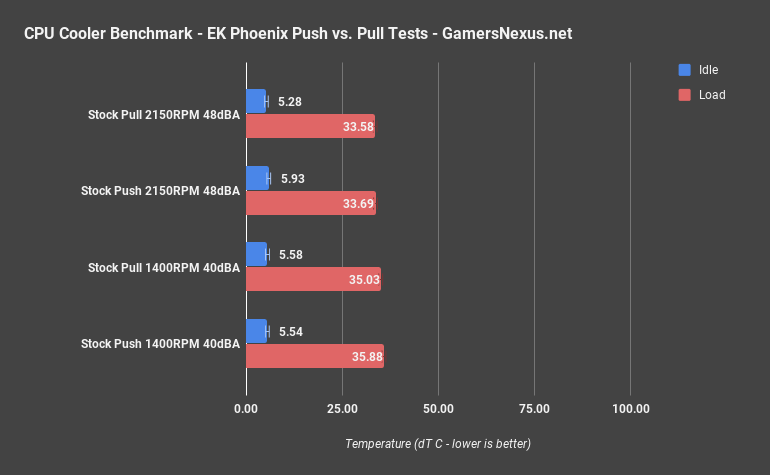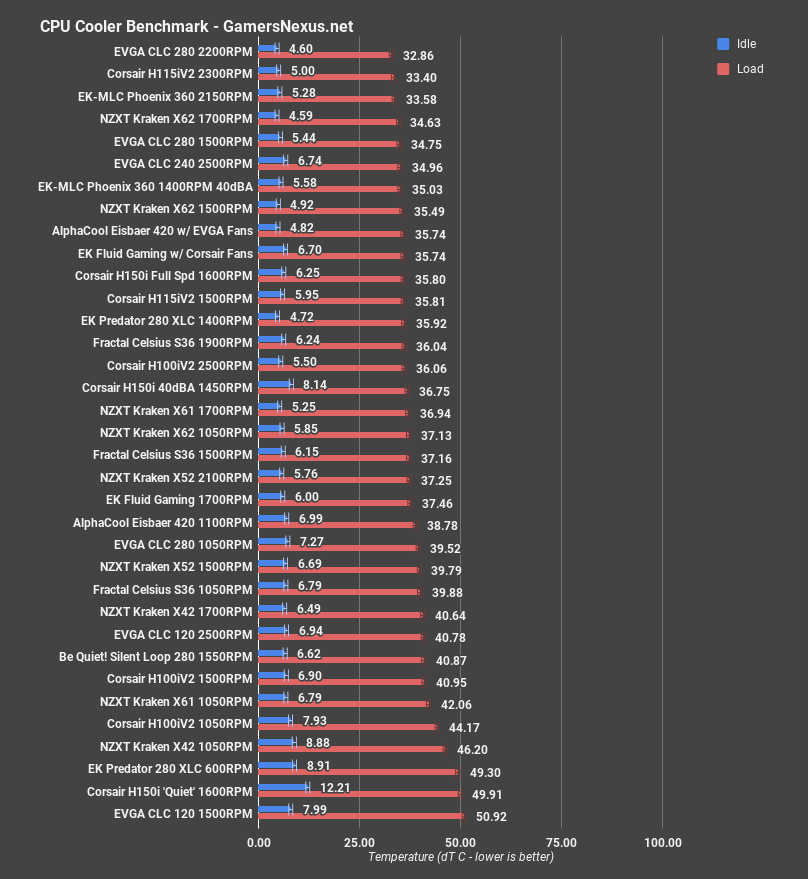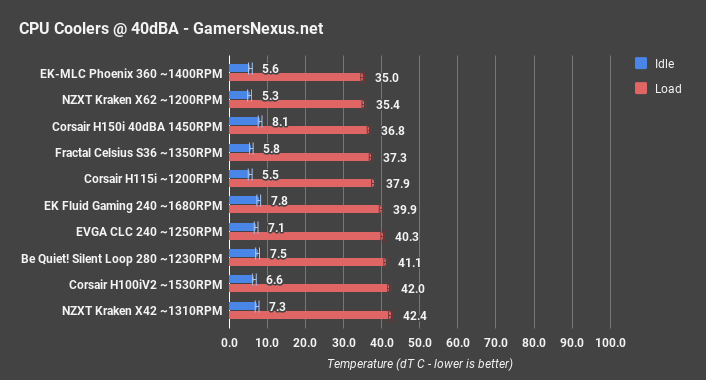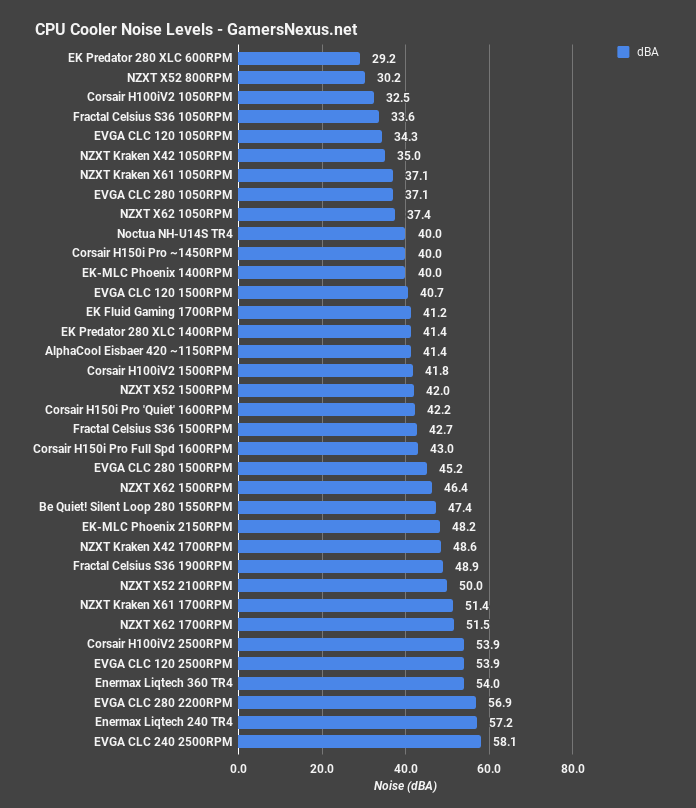EK Waterblocks makes some of our favorite quick release valves, but their previous attempt at a semi-open loop liquid cooler – the EK Predator – terminated after an overwhelming amount of issues with leakage. It was a shame, too, because the Predator was one of the best-performing coolers we’d tested for noise-normalized performance. Ultimately, if it can’t hold water, it’s all irrelevant.
EK is attempting to redeem themselves with the modular, semi-open approach set-forth with the new EK-MLC Phoenix series. A viewer recently loaned us the EK-MLC Phoenix 360mm cooler and Intel CPU block ($200 for the former, $80 for the latter), which we immediately put to work on the bench. This review looks at the EK-MLC Phoenix 360mm radiator and CPU cooling block, primarily contending against closed-loop liquid coolers (like the H150i Pro and X62) and EK's own Fluid Gaming line.
The EK-MLC Phoenix is a semi-open loop design that uses EK’s quick disconnect valves, which we’ve previously praised highly for their ease-of-use and snap-fit functionality. The valves return on the Phoenix, as does the pump-on-rad design, making for a significantly fatter radiator than is typical on a closed-loop liquid cooler. This will not fit top-mounted in many cases, but a front mount should be fine; top mounts will work in larger cases that account for open loop designs, as EK’s Phoenix is essentially designed like an open loop product.
The Phoenix takes a modular approach to things. The radiator, CPU block, and GPU blocks are all sold separately, making it possible to mix-and-match radiator sizes and component cooling. The viewer who loaned us this unit purchased only the CPU block and 360mm radiator (costing upwards of $280), but you could add a GPU block as well, and that’s where the cooler begins to pull away from the capabilities of closed-loop products.
We had zero leak during installation and setup. As long as the female valve is held upward, all liquid can be contained if installing carefully. We would still advise paper towels around or under the valve fittings for first power-on, but for our installation, these went (thankfully) unused. EK ships the valves with balloons on one end, making it easier to minimize liquid loss during first connections. It should be possible to add a GPU block later and without concern of leaks, though again, we’d recommend paper towels at contact joints for initial testing.
Our only complaint with the unit was some pump whine. At max pump RPM, which is what you’d want if cooling both a CPU and GPU, our test unit had some audible whine at a higher frequency than the whirr of the fans. Lowering the pump RPM resolves this, but also reduces cooling efficacy on full loops. It would be acceptable on a single-component loop.
CPU Cooler Test Methodology
CPU cooler testing is conducted using the bench defined below. We use a bench that is more carefully crafted for noise performance, opting for a passively cooled PSU and 23% RPM 980 Ti blower fan for very low system noise.
We strongly believe that our thermal testing methodology is among the best on this side of the tech-media industry. We've validated our testing methodology with thermal chambers and have proven near-perfect accuracy of results.
Conducting thermal tests requires careful measurement of temperatures in the surrounding environment. We control for ambient by constantly measuring temperatures with K-Type thermocouples and infrared readers. Two K-Type thermocouples are deployed around the test bench: One (T1) above the bench, out of airflow channels, and one (T2) approximately 2-3" in front of the cooler's intake fan. These two data points are averaged in a spreadsheet, creating a T3 value that is subtracted second-to-second from our AIDA64 logging of the CPU cores.
All six CPU cores are totaled and averaged second-to-second. The delta value is created by subtracting corresponding ambient readings (T3) from the average CPU core temperature. We then produce charts using a Delta T(emperature) over Ambient value. AIDA64 is used for logging thermals of silicon components, including the CPU and GPU diodes. We additionally log core utilization and frequencies to ensure all components are firing as expected. Voltage levels are measured in addition to fan speeds, frequencies, and thermals.
The cores are kept locked to 3.8GHz (x38 multiplier). VCore voltage is locked to 1.141v for the CPU. C-States are disabled, as is all other power saving. The frequency is locked without any interference from boost or throttle functions. This is to ensure that the CPU does not undergo any unexpected/uncontrollable power saving or boost states during testing, and ensures that the test platform remains identical from one device to the next.
Fan speeds are manually controlled unless otherwise defined. For liquid coolers, pumps are set to 100% speed unless otherwise defined.
No open bench fans are used for these CPU cooler tests. Only fans which are provided with the cooler are used.
| GN Test Bench 2015 | Name | Courtesy Of | Cost |
| Video Card | GTX 980 Ti Reference 23% RPM | NVIDIA | EOL |
| CPU | Intel i7-5930K CPU @ 3.8GHz | iBUYPOWER | $580 |
| Memory | Corsair Vengeance 32GB 2666MHz | Corsair | $175 |
| Motherboard | EVGA X99 Classified | GamersNexus | $365 |
| Power Supply | Enermax DigiFANLESS | Enermax | $250 |
| SSD | HyperX Savage SSD | Kingston Tech. | $130 |
| Case | Top Deck Tech Station | GamersNexus | $250 |
| CPU Cooler | This is what we're testing! | - | - |
We use an AMPROBE multi-diode thermocouple reader to log ambient actively. This ambient measurement is used to monitor fluctuations and is subtracted from absolute GPU diode readings to produce a delta value. For these tests, we configured the thermocouple reader's logging interval to 1s, matching the logging interval of GPU-Z and AIDA64. Data is calculated using a custom, in-house spreadsheet and software solution.
Our test starts with a 180s idle period to gauge non-gaming performance. A script automatically triggers the beginning of a CPU-intensive benchmark running Prime95 LFFTs. Because we use an in-house script, we are able to perfectly execute and align our tests between passes.
Push vs. Pull Radiator Setup – EK-MLC Phoenix 360mm
We’re starting out with a chart that only shows our EK-MLC Phoenix tests, and we’ll add the rest of the coolers momentarily. This chart shows all of our Phoenix tests, including some quick push/pull configurations and noise-normalized 40dBA configurations.
The complete stock, out-of-box configuration did best, operating with a load temperature of about 33.6 degrees over ambient. This was followed by a push configuration, using an Allen key to flip the fans around, which gave us a 33.7-degree delta T over ambient. That’s completely, 100% within error margins, and would suggest that there is no appreciable difference between push and pull configurations in an open-air format. The impact would be more dependent on your specific case and cooling configuration than on the cooler and fans.
Normalizing at 40dBA increases our temperatures by a couple degrees and the increase is outside of error margins; although this is a measurable difference, it would not be appreciable to most users. We’ll talk about this more in a moment.
EK-MLC Phoenix 360 Steady State Thermals vs. Corsair H150i Pro
Moving on to our steady state chart for all tested devices, the EK-MLC Phoenix readily claims its position among the top three coolers we’ve tested. Its performance is within error margins of the EVGA CLC 280 and Corsair H115i. We do not have the measurement resolution required to determine any difference between these three devices. In the very least, we can confidently state that the EK-MLC Phoenix 360mm unit, cooling only the CPU, is a top-3 cooler on our charts. Its performance is admirable, and the cooler’s Varder fans are a large contributor to the advantaged cooling capabilities.
To give some perspective on where the Phoenix leads, we see it ahead of the Kraken X62 – outside of error margins – and ahead of the Eisbaer 420, which suffers from both awful fans and a pump which is comparatively anemic to the large radiator size.
More importantly, the EK Phoenix 360 silenced to 40dBA performs better than 80% of our charted items, meaning that its lower noise performance exceeds the flat-out performance of most of its competitors. We don’t have every single cooler we’ve tested on this chart – mostly because we’d run out of space – but the EK Phoenix at 40dBA lands at 7th versus 40 tested configurations on this test bed, most of which are also liquid coolers. That’s damn good performance.
EK Phoenix 360mm Noise Normalized Performance – Best Liquid Coolers
Normalizing for 40dBA, the EK-MLC Phoenix 360mm unit chart-tops, though is technically within margin of error of our second-place line-item, the Kraken X62 280mm cooler. The Phoenix ends up at 35 degrees delta T over ambient, and is most immediately comparable in size to the 360mm Corsair H150i, landing at 36.8dBA. Of course, as always, this is for noise levels in decibels, not for type of noise. Although the EK Phoenix does rank as best for noise-normalized performance, it still has audible pump whine during use. You may want to manually step-down the pump if using this only to cool a CPU, though the higher speed will significantly benefit combined CPU+GPU loops. We’re not sure if the pump whine is just in our sample or a wider-spread issue, but one noteworthy item is that we were able to reduce some other noises, like turbulence from the fans, by remounting the fans and resecuring the cables.
Flat-Out Noise Levels of EK-MLC Phoenix
As for flat-out noise, tested in our standardized environment with a noise floor of 26dBA, the EK Phoenix ends up at about 48dBA, but can spike up to about 50dBA when pump whine gets bad. This does make it one of the louder coolers, but not the loudest – that’d still go to EVGA. Loudness is ultimately a function of how fast a manufacturer is allowing its fans to spin. What’s more important is the noise-normalized thermals, which help illustrate how well a cooler can perform when under noise-constrained conditions.
EK-MLC Phoenix Conclusion
The cooler performs exceptionally well, but it’s also very expensive. You’re looking at about $280 to buy the 360mm radiator and the CPU block. This is a semi-open loop – it’s something you buy if planning to add semi-modular GPU blocks in the future. The idea is an easy-to-deploy loop that follows the disciplines of both closed- and open-loop coolers. Of course, as price increases, you still begin nearing the cost of a truly open loop. Adding multiple GPUs would be particularly inadvisable here, as the tubing length is less customizable and the pump strength is fixed.
That said, as a standalone cooler, it’s clear that the EK-MLC Phoenix is the best liquid cooler we’ve presently tested for noise-normalized performance. Part of that is the fans, part is the pump strength, and part is the thickness of the radiator. The cooler provides a strong, expensive baseline for trying out a semi-open loop, but without the compatibility and setup requirements of a truly open loop. Value is a tough argument. You could spend $100 less and get a closed-loop cooler that is nearly equal in performance – or close enough to be irrelevant. The closed-loop cooler can’t be expanded later, though, and that’s where the EK Phoenix steps in. It’s a very specific use case and niche, but one which EK seems dead-set on carving-out for itself.
Editorial, Testing: Steve Burke
Video: Andrew Coleman



